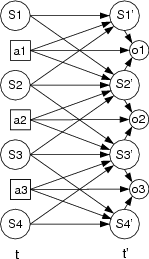Project Abstract
In this project we study planning under uncertainty for
groups of cooperating multiagent systems. Developing
intelligent robots or other real-world systems that plan
and perform an assigned task is a major goal of
Artificial Intelligence and Robotics. We develop general
methodology and algorithms, and tackle case studies such
as multi-robot urban search and rescue.
Planning, or sequential decision-making skills form a
crucial component of any intelligent system: how should
a system act over time in order to perform its task as
well as possible. When a system is part of a team, its
performance depends on the actions chosen by its
teammates. An important aspect of decision making in a
real-world system is the fact that the system should be
able to deal with uncertainty from numerous sources. For
instance, a major source of uncertainty for a robot are
its sensors, which are often noisy and have only a
limited view of the environment. A robot is also often
uncertain about the effect that executing an action has
on its environment. A third source of uncertainty are an
agentīs teammates, as, in general, an agent will not be
able to predict with full certainty what actions its
teammates will perform. Furthermore, one has to consider
the communication abilities available to each system and
restrictions on available bandwidth or network
reliability.

|
|
We develop algorithms that allow systems to handle
uncertainty in sensors, actuators, communication,
and teammate behavior in a principled way. We
capture uncertainty in probabilistic models, which
allows us to model the sequential decision-making
problem as a centralized or decentralized
partially observable Markov decision process
(POMDP). Decentralized POMDPs (DEC-POMDPs) form a
general framework for representing cooperative
planning under uncertainty problems. In this
project, we focus on the following issues: (1)
developing approximate planning algorithms for
relevant subsets of the general DEC-POMDP model,
(2) examining the tradeoff between centralized
vs. decentralized planning algorithms and (3)
tackling various communication
models. Furthermore, we see how these techniques
can be used in case studies.
|
|

